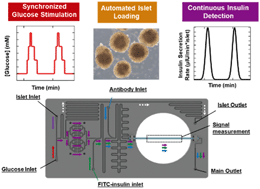Synchronized stimulation and continuous insulin sensing in a microfluidic human Islet on a Chip designed for scalable manufacturing†
Abstract
Pancreatic β cell function is compromised in diabetes and is typically assessed by measuring insulin secretion during glucose stimulation. Traditionally, measurement of glucose-stimulated insulin secretion involves manual liquid handling, heterogeneous stimulus delivery, and enzyme-linked immunosorbent assays that require large numbers of islets and processing time. Though microfluidic devices have been developed to address some of these limitations, traditional methods for islet testing remain the most common due to the learning curve for adopting microfluidic devices and the incompatibility of most device materials with large-scale manufacturing. We designed and built a thermoplastic, microfluidic-based Islet on a Chip compatible with commercial fabrication methods, that automates islet loading, stimulation, and insulin sensing. Inspired by the perfusion of native islets by designated arterioles and capillaries, the chip delivers synchronized glucose pulses to islets positioned in parallel channels. By flowing suspensions of human cadaveric islets onto the chip, we confirmed automatic capture of islets. Fluorescent glucose tracking demonstrated that stimulus delivery was synchronized within a two-minute window independent of the presence or size of captured islets. Insulin secretion was continuously sensed by an automated, on-chip immunoassay and quantified by fluorescence anisotropy. By integrating scalable manufacturing materials, on-line, continuous insulin measurement, and precise spatiotemporal stimulation into an easy-to-use design, the Islet on a Chip should accelerate efforts to study and develop effective treatments for diabetes.



 Please wait while we load your content...
Please wait while we load your content...
